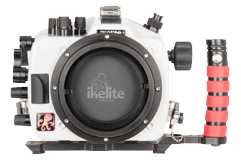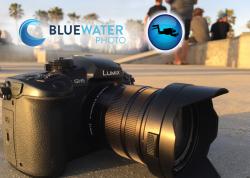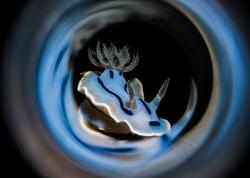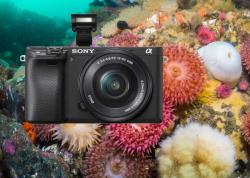Sony A7S III Review
The Sony A7S III is a testament to the fact that Sony truly listens to its constituency. This new, video-oriented full frame mirrorless camera is designed with video workflow and low light performance as the centerpiece of Sony's engineering. A crisp, practically noise-less 4K image can be squeezed from the darkest of situations - where we find that even ISOs of 16,000 and higher are useable. The A7S III shoots 4K up to 120 frames per second for the ultimate stabilization in post processing as well as 10-bit 4:2:2 with internal recording for the best possible color gamut usable while color grading any of the wide selection of logarithmic picture profiles.
The A7S III is also a very formidable stills camera for anyone willing to compromise with 12 megapixels of resolution. The autofocus system is, of course, one of the quickest in the world with the stickiest autofocus tracking on the market. Perhaps most importantly, the A7S III does not have recording limits and is less likely to heat while taking video at high frame rates as compared to the renowned Canon EOS R5. We took the Sony A7S III, which we are dubbing "the low light king" and 2020's underwater video camera of the year, diving in the dark, gloomy waters of the Olympic Peninsula. The results speak for themselves.
Status: Shipping Now!
U.S. MSPR: $3,498
Order a Sony A7S III underwater housing at Bluewater Photo:
Nauticam Sony A7S III Underwater Housing
Ikelite Sony A7S III Underwater Housing
Sea & Sea Sony A7S III Underwater Housing
Aquatica Sony A7S III Underwater Housing
Isotta Sony A7S III Underwater Housing
Marelux Sony A7S III Underwater Housing
Order a Sony A7S III Camera Body at Bluewater Photo:
Read Our Top Sony A7S III Underwater Settings
Check out our full Sony A7S III Underwater Housing Buyer's Guide
Contact Us for a Special Sony A7S III Underwater Package
Jump to a Section
Sony A7S III Specifications | Sony A7S III vs Canon EOS R5 | Sony A7S III Features
Sony A7S III for Underwater Video | Sony A7S III for Underwater Photo
Best Lenses | Best Sony A7S III Underwater Housings | Conclusion
Key Sony A7S III Specifications
- 12 MP BSI CMOS Sensor
- Bioz XR Image Processor
- ISO 80-102,400
- "Low Base" and "High Base" (effectively dual gain) ISO capability for better low light shooting
- 4K video up to 120 fps
- No recording time limits. Could be limited by heat (4K @ 60p for at least an hour)
- 10bit 4:2:2 internal recording
- S-LOG, HLG, and Cine type log picture profiles available
- 4K @ 60p, 16-bit RAW video recording with an external recorder
- 5 axis in-body image-stabilization (IBIS), new active steadyshot stabilization mode (incorporates digital image stabilization)
- Dual card slots (either SD or CFexpress Type A)
- 9.44 M dot EVF - the best resolution on the market!
- Movie file formats: XAVC S (Long GOP, H.264 MP4); XAVC HS (Long GOP, H.265 HEVC); XAVC S-1 (All-Intra, H.264 MP4)
- AF tracking with human and animal eye AF capability
- 759 point hybrid AF system and 425 contrast detection points
- Weight: 21.7 oz (617g) with batteries
- Size: 5.1 X 3.8 X 2.7 in (129 X 97 X 70mm)
Sony A7S III vs the Canon EOS R5
The Sony A7S III and the Canon EOS R5 don't really compare as far as cameras go, but both Sony and Canon positioned themselves for a comparison with their marketing. Canon began by introducing amazing video specs on the EOS R5, capable of 8K RAW internal recording @ 30 fps. The EOS R5 can also record 4K video up to 120fps. Due to the limited number of pixels on the sensor, the A7S III is only capable of shooting 4K video up to 120fps. That being said, 8K video is the only spec where Canon is superior.
The A7S III is a camera that's designed for much more practical video usage - mostly because it doesn't overheat as quick as the EOS R5. The A7S III can shoot 4K @ 120 fps for at least an hour at room temperature whereas the EOS R5 can shoot at that frame rate for only 15 minutes. For most applications, the A7S III is going to be the better choice. Very few individuals have a need for 8K video and want to deal with the processing and data demands that come with it. For underwater videographers looking to shoot smooth 4K video at 60fps or 120fps, the Sony A7S III is going to be the camera of choice.
When it comes to lowlight capabilities, the A7S III performs much better than the R5 due to its lower resolution sensor. Have a lower resolution sensor, means each pixel on the A7S III is larger and can collect more light per pixel. This results in smoother, more detailed video at higher ISOs. We found that even video at ISO 16,000 was crisp. The A7S III is also equipped with a "high base" ISO of 12,800 which means shooting at higher ISOs can actually result in slightly less noise than ISOs just below 12,800. This was useful when shooting log picture profiles.
Ultimately, the A7S III has a much wider range of workflow options than the R5. The A7S III has many more log profile for different shooting situations (as we outlined in our settings article). However, the R5 does offer internal RAW recording whereas the A7S III can only record RAW video to an external recorder. We think the R5 is a better choice for videographers who need 8K video for crops (particularly macro shooters) and people that want to shoot RAW or use animal eye AF tracking. The Canon EOS R5 is going to be a much better camera for those who want to focus on still photography as well. We think the Sony A7S III is a better option for serious video shooters who don't want to focus on still photography. It's an especially appealing camera to videographers that need high-quality, noise-less video in very lowlight (i.e., divers). Finally, for anyone who shoots continuous video for long periods of time, the A7S III is a better option with no recording limits.
Top Sony A7S III Features
Build and Ergonomics
The Sony A7S III is one of Sony's better builds. The layouts of the buttons and dials are similar to other alpha cameras, but it has a different body than the Sony A7III/A7R III. Therefore it does require a different underwater housing. The body has three dials that can be used to control aperture, shutter speed, and ISO - including one on the D-Pad on the back. However, the back dial may not be supported by all underwater housing manufacturers. AF point selection is controlled by touch screen and joystick - which makes it really easy to control for topside shooting. Unfortunately, not all housings will support the AF joystick. But there are workarounds to select your AF point for both photo and video as we describe in our settings article.
The A7S III's EVF currently has the highest resolution on the market and it's very apparent. The dynamic range is excellent. However, most underwater video shooters are likely going to want to use the LCD or an external monitor. The body has a dual card system built in that can accommodate CFExpress Type-A and UHS-II cards, We recommend using CFExpress cards to be able to shoot at higher bitrates of up to 600M.
The A7S III is equipped with a new menu. Sony shooters are going to be very happy, though it is not quite as user-friendly as Canon and Nikon menus. Many of the confusing labels have been altered for better understanding and the menu system has been flipped 90 degrees and color coded. Overall we enjoyed it much more than other Sony menus and found it very easy to use an navigate underwater.
Battery Life
The battery life on the A7S III is very good for a video system. We were able to get about three dives on one battery with a focus on shooting video for most of the dives. If you are shooting a lot of video at high frame rates, the battery might die on the third dive. If you are shooting just photos, the battery will likely last four dives.
Image/Video Quality and Lowlight Performance
The secret to the Sony A7S III is the relatively low resolution, 12 MP BSI CMOS full-frame sensor. When it comes to video, you want to have as close to a 1 to 1 pixel readout as possible. Therefor, 12 megapixels is ideal for shooting 4K. With less processing power needed to downsample pixels, the processors can put more effort into shooting at higher frame rates and higher compression. Lower resolution sensors also result in much less noise in the image because each pixel is larger and can collect more light. This is why the photo quality is great at ISOs about 1250 and the video quality is great even at ISOs of 16,000 and higher. Being able to shoot at these high ISOs allows you to capture images in low light with quick shutter speeds for a crisp shot and higher f-stops for more depth of field. If you are a more photo oriented shooter, than it's important to consider that 12 megapixels is a great resolution for social media, youtube thumbnails, other day to day usage, and medium size prints. However, if you would like to have very large prints or you shoot a lot of macro and need close crops, the A7S III isn't the top choice for a photo oriented camera.
Stabilization
The Sony A7S III is equipped with some additional stabilization features specifically designed for video shooting. The sensor is stabilized with 5 axis in-body image-stabilization. We find the IBIS in the A7S III to be good but not as good as Nikon's or Canon's. The Canon EOS R5 is especially notable as having the best IBIS on the market with a noticeable advantage when compared to the A7S III.
However, Sony has added an "active steadyshot" stabilization mode. This mode has a slight crop and adds digital image stabilization to the shot. Unlike competing brands, we didn't find any warpiness in the video. We used active steadyshot in most of our handheld video and liked the results. The added crop factor did not feel like much of an issue for us - especially when shooting with the Canon 8-15mm (which can be zoomed out past the barrel of the lens) and the Sigma 105mm macro (where the crop factor is an added benefit). When your camera is on a tripod underwater, we recommend using standard steady shot.
Autofocus
The autofocus system on the Sony A7S III is one of the best in the world. It's much more similar in functionality to the Sony A7R IV than the A7R III. The autofocus tracking system does a great job of sticking to the autofocus point and we used it frequently in photo modes. However, we could not get the animal eye autofocus to function at any point during our tests with fish. The Canon EOS R5 is much more useable when it comes to animal eye autofocus.
In video modes, you cannot select a point for AF tracking underwater. We recommend using the wide autofocus mode for wide angle video. For macro, we recommend using AF to lock your focus pont and then toggling to manual. A housing with joystick compatibility will allow you to select an AF point manually. However, when you are shooting macro video in AF mode, switch to MF when recording to save your shot from focus breathing.
Sony A7S III for Underwater Video
When it came to the A7S III, Sony didn't veer away from the goal. It's pretty clear that the A7S III is top full-frame mirrorless camera for underwater video in 2020. It beats out competitors like the Pansonic S-series with better lens options and the Canon EOS R5 with better engineering and recording times. The 12 megapixel BSI CMOS sensor makes it an extremely capable low light video camera with large pixels. The dual gain function provides high and low base ISOs so that you can shoot in really low light with limited noise. We found our underwater video to be extremely crisp and high quality even at ISO 16,000. This allows videographers to shoot in Log profiles without too much nose in their shot. Our 10-bit 4:2:2 footage made color grading easy - even in shots where the white balance was slightly off. If you intend to shoot any kind of Log footage, we highly recommend recording in 10-bit 4:2:2. But if you intend to publish your videos on youtube and just need to shoot in the standard picture profile (which is excellent), then 8-bit 4:2:0 will be just fine.
The combinations of Sony's IBIS and 4K recording at 120 frames per second makes this camera a formidable choice if you need to shoot some action underwater (e.g., surfing, bait balls, sea lions, sharks, ect). You can slow down any shot to your hearts desire in post processing, and we frequently shot at 120 frames per second and slowed down the footage 4 times. This was especially useful when shooting handheld macro video.
Simply put, if you're a video shooter the A7S III has everything you might think of.
Video File Types and Codecs
The Sony A7S III has a wide range of options when it comes to video recording file types, bit rates, and codecs. We recommend shooting 4K as this detail and resolution on this camera is wonderful. There are only options to shoot in 4K or HD. With HD video you can take advantage of the super 35 mode for quick cropping when needed. In most cases, we recommend shooting with the XAVC S file type. This is an H.264 standard that is compatible with most editing workflows and has the most options for frame rates and bit rates. 4K @ 60p is going to be the best option for most underwater video as you will be able to slow down shaky footage in post processing. If you need extra stability, then shooting at 120p is a good idea. Keep in mind that the data will start piling up on your card. If you are shooting a logarithmic picture profile like S-Log2 or S-Log3 then we highly recommend using 10-bit 4:2:2 recording for accurate color grading. We found it very useful for correcting white balance. If you are shooting in the standard profile, 8-bit 4:2:0 is just fine. For more information about video file types, picture profiles, and codecs, please see our settings article.
Sony A7S III for Underwater Photography
Yes, the A7S III is a video oriented system, but it is a very formidable stills camera as well. This is because the photo functionality in the body has been updated with much of Sony's latest photo technology, including a very competent autofocus system. Although the resolution isn't as high as other photo-oriented cameras on the market, the added benefit of the 12 megapixel full-frame sensor, is that you can shoot at extremely high ISOs and still get great images. So if you're a cold water diver frequently in dark lighting situations, this could be a camera to consider. We using high ISOs to be very useful when taking photos with video lights. The major downside, of course, is that 12 megapixels is not enough for large prints or close crops and falls below the standard of the day.
Best Underwater Lenses for the Sony A7S III
In recent years, Sony has gone from having a limited supply of lenses for underwater photography to one of the best repertoire of native lenses for full-frame mirrorless cameras on the market. Sony A7S III users have an excellent set of choices for shooting macro, wide, mid-range, and fisheye.
Wide-Angle Lenses
The Sony 16-35mm F4 lens is the top wide-angle lens choice for photo and video. If you’re looking for something even wider to get nice close-focus wide-angle (CFWA) shots of reefs there are a couple of options for shooting fish-eye. The 28mm prime lens with a fisheye conversion lens will give the widest possible angle of view. The fisheye conversion lenscan be used behind a large or small dome port, while the Sony 16-35 mm F4 les is recommended for use with an 8-inch dome or larger.
Wet wide-angle lenses are a great option with this camera. We recommend the Nauticam wet wide-angle lens or the Kraken KRL-01 wet wide-angle lens with the 28mm prime lens. All of these options are very sharp and will result in stunning wide-angle photos.
Mid-Range Lenses
The Sony 24-70mm F 4 or the Sony 28-70mm F3.5-F5.6 are good choices along with the 35mm F2.8 portrait lens.
Macro Lenses
For underwater photography, the Sony 90mm macro prime lens is the best choice for small fish and macro subjects. It is exceptionally sharp and produces high quality images. A 50mm macro lens is another great option, though it doesn't focus as quick as the Sony 90mm. Recently, the Sigma 105mm f/2.8 DN DG Art macro lens was reviewed by Bluewater Photo. It looks like it's going be an excellent alternative to the Sony 90mm with potentially better image quality! We shot all of our macro images in this review with the Sigma 105mm.
Canon Lenses
Canon lenses can be attached to the Sony A7R IV with the Metabones, Sigma MC-11, or Photodiox adapters, but auto-focus is generally better with Sony lenses. Lenses like the Canon 8-15mm, 16-35mm, 17-40mm, and 100mm can work well.
We shot our wide angle images in this review with the Canon 8-15mm. We found the autofocus to be very slow with the metabones adapter.
Top Underwater Housings for the Sony A7S III
Currently there are two excellent housing options out for the Sony A7S III and we anticipate more to come to the market soon. Ikelite offers an excellent, lightweight polycarbonate housing. Nauticam offers a high-quality aluminum housing for the Sony A7S III. Due to the differences in body design, different housings are necessary for the A7S III, A7III, and A7S II.
Ikelite Sony A7S III Housing
The Ikelite Sony A7S III 200DL Underwater Housing is built from a high quality, corrosion free ABS-PC blend polycarbonate housing which makes it sturdy and impervious to corrosion. The housing offers full control of the camera with controls that are designed to be easy to use. This housing is great for anyone looking for an amazing price point. The Ikelite Sony A7S III housing features a clear back so you can easily monitor the housing for any leaks. The built-in vacuum system adds an extra level of protection from such events. This housing does not have full compatibility with the joystick, please see our settings article for AF point selection workarounds.
Nauticam Sony A7S III Housing
The Nauticam Sony A7S III Underwater Housing is built from aircraft grade aluminum which makes it durable and lightweight. Camera controls are very easy to access with buttons, levers, and knobs all within easy reach. It also comes with a vacuum valve pre-installed for ultimate peace of mind. Nauticam housings are universally popular and this housing is rated to 100 meters depth.

Marelux Sony A7S III Underwater Housing
This Marelux underwater housing is built from high-grade aluminum alloy which provides durability and can withstand even the toughest beatings. Ergonomics are also top-notch, all camera controls are readily available at your fingertips and all buttons are clearly labeled. Thanks to its small size, it is great to travel with. Assembling the housing itself and installing a camera is a breeze with its quick release plate so you can spend more time under the water and less time setting up your gear. With a depth rating of 100m, this housing is an excellent option for both recreational divers as well as technical divers.
Conclusion
The Sony A7S III is our top full-frame mirrorless camera for underwater video in 2020. It features dual gain ISO capability, 4K video up to 120 fps with no recording limits, 16 bit RAW recording up to 4K @ 60fps (with an external monitor), S-Log profiles with 15 stops of dynamic range, dual card slots, IBIS, and an amazing 9.4 million dot EVF. For real world use, underwater videographers have just been given a new cutting edge tool to produce spectacular, smooth, colorful scenes for years to come.
Order a Sony A7S III underwater housing at Bluewater Photo:
Nauticam Sony A7S III Underwater Housing
Ikelite Sony A7S III Underwater Housing
Sea & Sea Sony A7S III Underwater Housing
Aquatica Sony A7S III Underwater Housing
Isotta Sony A7S III Underwater Housing
Marelux Sony A7S III Underwater Housing
Order a Sony A7S III Camera Body at Bluewater Photo:
Read Our Top Sony A7S III Underwater Settings
Check out our full Sony A7S III Underwater Housing Buyer's Guide
Contact Us for a Special Sony A7S III Underwater Package
RECOMMENDED ARTICLES
SUPPORT THE UNDERWATER PHOTOGRAPHY GUIDE:
The Best Service & Prices on u/w Photo Gear
 Visit Bluewater Photo & Video for all your underwater photography and video gear. Click, or call the team at (310) 633-5052 for expert advice!
Visit Bluewater Photo & Video for all your underwater photography and video gear. Click, or call the team at (310) 633-5052 for expert advice!
The Best Pricing, Service & Expert Advice to Book your Dive Trips
 Bluewater Travel is your full-service scuba travel agency. Let our expert advisers plan and book your next dive vacation. Run by divers, for divers.
Bluewater Travel is your full-service scuba travel agency. Let our expert advisers plan and book your next dive vacation. Run by divers, for divers.












































